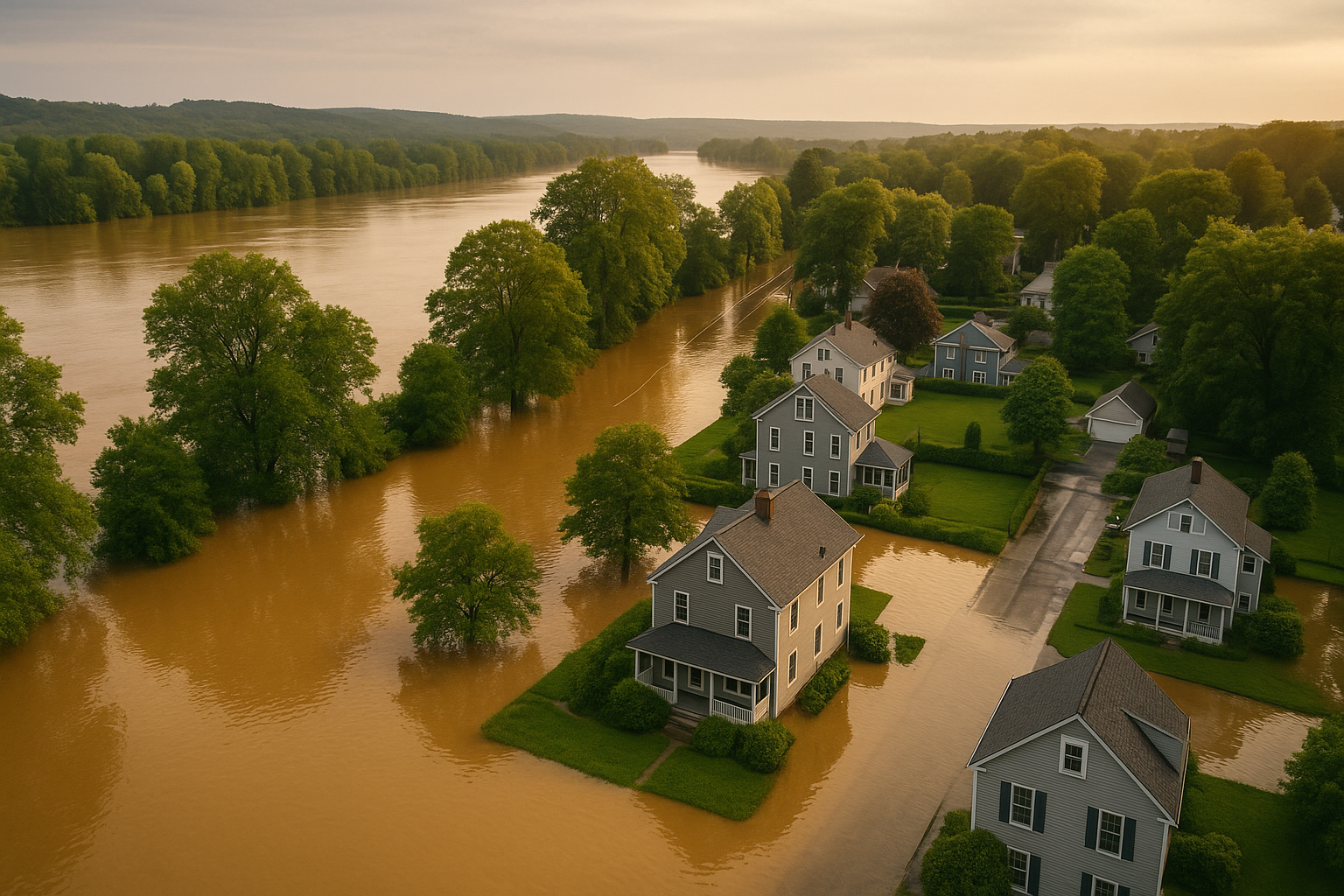Heavy spring rains and rapid snowmelt have swollen several New England rivers this week, prompting the National Weather Service (NWS) to keep active Flood Warnings on the Connecticut River at Hartford and Middle Haddam, CT, and extend warnings on tributaries such as the Suncook River at North Chichester, NH. At Hartford, the Connecticut River stood at 18.2 ft late Monday—more than two feet above the 16 ft flood stage—and is forecast to remain in minor‑flood territory until tonight. National Weather Service
Local impacts are already visible: the state‑operated Rocky Hill ferry is shut down, and low‑lying park roads from Wethersfield through Portland remain underwater. CT Insider Over the weekend, gauges briefly spiked to 19–20 ft, and forecasters warned the river could crest near 20 ft again if another round of rain materializes. Stamford Advocate Farther north, the Suncook River’s banks topped the 7 ft flood mark on May 11 and minor flooding is forecast to linger through mid‑week for Belknap and Merrimack counties. Local Conditions
If you own property anywhere near these waterways—or anywhere downstream—now is the time to act. Here’s how to protect your claim prospects before the water retreats and adjusters arrive.
1. “Flood” vs. “Water Damage”: Why the Label Matters
Most home policies cover burst pipes or roof leaks but exclude flood, which FEMA and insurers define as rising surface water covering at least two acres or affecting two properties. That means:
-
Separate policy – usually through the National Flood Insurance Program (NFIP) or a private flood insurer.
-
Different deductible – flood often carries a higher, flat deductible.
-
Basement limits – finished walls, flooring, and personal property below grade may be capped or excluded altogether.
Knowing which policy to trigger—and doing it fast—prevents costly delays later.
2. Five Things to Do Right Now
-
Document the waterline
Snap photos of high‑water marks on every exterior wall and major interior room. Include a recognizable object (yardstick, shovel) for scale. -
Shut off power safely and list submerged appliances
Only after utilities declare it safe, cut breakers and take a phone pic of each affected circuit. Create a quick list: furnace, washer, fridge, etc. -
Save a sample of ruined materials
Bag a one‑square‑foot section of wet drywall or insulation. Moisture readings later prove how high water climbed and stop carriers from low‑balling tear‑out. -
Hire your own mitigation crew
Carriers’ preferred vendors may be backed up. A local, IICRC‑certified firm can start extraction and drying today; keep invoices for reimbursement. -
File notice in writing—email counts
Send a short “We’ve had a flood loss at [address] on May 12 2025” note to both your homeowners and flood insurer. Get a claim number in return.
3. Common Spring‑Flood Claim Pitfalls
-
Finished‑basement surprises – NFIP pays for mechanicals (furnace, water heater) but not carpet, drywall, or furniture below grade.
-
Code‑upgrade costs – electrical panels, GFCI outlets, and elevated HVAC units add thousands, yet many policies limit or exclude Ordinance & Law coverage for flood repairs.
-
Mold deadlines – carriers often deny mold remediation if drying isn’t underway within 48–72 hours. Keep your dehumidifier receipts and log humidity readings daily.
4. How Fire Claims Solutions Helps
-
Laser‑measured waterlines & drone imagery to prove structural damage beyond cosmetic cleanup.
-
Xactimate estimates that include extended equipment‑rental days and dehumidification most insurers omit.
-
Proof‑of‑Loss drafting – NFIP requires a signed, itemized Proof within 60 days of the flood date; missing that deadline is the #1 reason homeowners lose benefits.
-
Policy‑gap review – We’ll flag limits on basements, contents, or code upgrades and coordinate with surplus‑lines markets if you need short‑term supplemental coverage.
5. Quick Resources
-
FEMA NFIP Hotline (800‑427‑4661) – check your policy, start a claim, or locate a local flood‑insurance agent.
-
Connecticut River Stage Forecasts – water.weather.gov (search “HFDC3” for Hartford or “MHDC3” for Middle Haddam).
-
NWS Gray, ME River Warnings – weather.gov/gwx (covers NH rivers like the Suncook).
-
Volunteer Cleanup – Keep NH Beautiful and CT River Conservancy post sign‑ups within 48 hrs of flood crest.
6. Bottom Line
Floodwater may linger for days, but the window to preserve your claim is measured in hours. Detailed documentation, fast mitigation, and strict NFIP paperwork deadlines separate full recoveries from financial headaches.
Fire Claims Solutions’ New England‑based public adjusters are on call 24/7. If the May 2025 floods reached your property—or you’re worried hidden moisture will spark a mold fight later—contact us today for a free on‑site moisture map and policy review.
Need help now? Call (781)608-0754 or visit FireClaimsSolutions.com—we can be at your door anywhere in New England within 24 hours.




